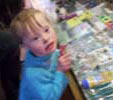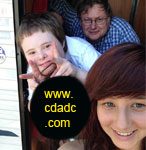

High Achievers With Down’s Syndrome
There are a number of people with Down’s Syndrome who have acheived a lot in our time.
These remarkable people with Down’s Syndrome have participated in everything from acting to sports, and usually provided inspiration to those around them at the same time.
The people with Down’s Syndrome featured here come from all backgrounds, education opportunities and circumstances.
One of the biggest things most noticed about people with Down’s Syndrome who achieve, is their unending grace and determination.
Stephanie Ginnsz
Stephanie Ginnsz was the first actor with Down’s Syndrome to ever star in a film.
She got the lead part in a film when she was twelve.
The film in question, “Duo”, was written and filmed by her brother in 1995. “Duo” won multiple awards including an official entry into the Academy Awards in 1996, the 1996 Martin Scorsese Film Post Production Award, the 1996 Warner Brothers Pictures Film Production Award, finalist status in the 1996 Chicago International Film Festival, 1996 Wasserman Award for Best Cinematography, and was nominated for the TASH Film and Media Award in 1997.
In the years since, Stephanie has gone on to graduate from the Walter Johnson High School in Bethesda, MD while being in one commercial and two theater plays.
She’ll continue to aim high throughout life.
Max Lewis
Max Lewis is a twelve year old boy with Down’s Syndrome from London who broke into Hollywood through participation in his local community theater.
After convincing his parents to let him try out in the audition he heard about through his local theater, he was chosen to play a child with Down’s Syndrome alongside Cate Blanchett, Bill Nighy and Judi Dench in the movie “Notes on a Scandal”. That movie has already premiered and been nominated for Golden Globe.
Because of it, he’s been cast for the role of a child (without Down’s Syndrome) for the movie “Trial and Retribution XIII” for which shooting will begin soon.
Joey Moss
Joey Moss, born in 1963, is the locker room attendant for the Edmonton Oilers hockey team.
Wayne Gretzky, the center for the Oilers at the time, suggested the young man for the job in 1985 after seeing the determination Joey brought to his previous job at a local bottle depot. The general manager, Glen Sather, agreed to try Joey out in the job, and he’s held it ever since.
In the summer of 1986, Wayne requested that Joey work for the Edmonton Eskimos during training camp so that he wouldn’t forget the duties and skills he’d learned in the off-season.
Due to the continuity and the higher level of social acceptance and friendship Joey experienced while working for two teams, he became an acknowledged expert in no time.
Joey Moss still works as the locker room attendant for the Oilers even today, long outlasting Gretsky and the other players he started with.
His passion for the game of hockey and determination have brought him nationwide celebrity.
The societies and organizations of professionaly hockey see him as a symbol of continuity within the game itself. He even delayed surgery for a hernia in 2006 in order to see his team play for the Stanley Cup.
His main duties today include cleaning the locker room, keeping track of towels, seeing to the team’s water and running errands for the equipment manager. His unofficial duties, of course, are to serve as the memory and soul of the team.
He recieved the National Hockey League Alumni Association’s “Seventh Man Award” in 2003 for his backstage service to the League.
His team, the Oilers, have also created the Joey Moss Cup, which they compete for in an annual split-team game near the end of training camp every year.
Paula Sage
Paula Sage is a Scottish actress born in 1980 with Down’s Syndrome.
She has also played netball in the Special Olympics and is an internationally recognized advocate of Down’s Syndrome. She serves as an ambassador for Down’s Syndrome Scotland and Mencap, and gives patronage and support to the Ann Craft Trust.
She performed in the 2003 English film “AfterLife” and won a Scottish BAFTA award for the Best First Time Performance.
She also won Best Actress in the 2004 Bratislava International Film Festival. The film won the Audience Award at the 2003 Edinburgh Film Festival.
She now plays a recurring role as Donna McCabe in the River City soap opera aired on BBC Scotland.
Judith Scott
This true story almost brought me to tears. An unfeeling and retarded society has much to answer for.
Judith Scott was a famous artist born on May 1st, 1943 with Down’s Syndrome and profound deafness. She had one fraternal twin, Joyce Scott, who did not suffer from Down’s Syndrome.
Judith was diagnosed with Down’s Syndrome at birth, but her deafness went undiagnosed for several years.
When the twins got to be school age, Judith was declared “ineducable” and ineligible even for classes for children with learning disabilities.
Because no one recognized the fact that she was deaf, she was diagnosed as profoundly retarded. Because of this faulty medical counsel, Judith’s parents had her institutionalized at the Columbus State Institution, a hospital for the mentally retarded.
Her separation from her fraternal twin had profoundly negative effects on both girls.
While at the Institution, Judith’s IQ tests came back placing her with a score of 30 based on oral tests. She no longer had her sister to translate and interpret for her the way she had as a small child. Because of this mistaken IQ test, she was denied any educational opportunities and became seriously alienated from those around her. She began to have behavioural problems and issues with integrating with other children. At some points she ate messily, tore her clothing, beat up other children, and generally did her best to express her profound anger at a world that ignored her.
In 1985, her twin Joyce realized that if she were Judith’s legal guardian, the twins could once more be together. After a complex legal battle, Judith moved to California with Joyce.
This was to have quite the effect as California protected the rights of all mentally retarded citizens to an ongoing education.
Judith started attending the Creative Growth Art Center in 1987. At first, she didn’t do very much with it, only scribbling loops and circles but nothing representational. Her response to normal visual arts was so lackluster that Joyce considered removing her from the program.
However, a few months later Judith happened to see a fiber art class conducted by a visiting artist, Sylvia Seventy, and her creativity exploded. While other students were stitching along according to the instructions, Judith started sculpting with fiber.
Her burgeoning creativity was quickly recognized and she was given all the freedom to choose art materials she desired. Her work mostly consists of found objects wrapped in a variety of carefully chosen colored yarns in order to create her sculptures.
Many of her works feature pairs, reflecting her deep connection with her twin.
Judith’s work became quite popular in some sections of the art world, and several of her pieces have been purchased by museums for their permanent collections. Her artworks often sell for $15,000 or more at art auctions today. Each and every piece reflects Judith’s unique perspective on the world.
Judith Scott died peacefully attended by her sister on March 15, 2005 at the age of 61, almost fifty years more than her doctors predicted at her birth.
Karen Gaffney
Karen Gaffney is a thirty year old woman with Down’s Syndrome who has achieved remarkable things, including a college education and a successful athletic career.
She graduated from high school at St. Mary’s Acadamy in Portland, Oregon in 1997, and went on to earn an associate’s degree and a teacher’s aide certificate from the Portland Community College in 2001.
Karen has always reached for the same goals and on the same playing field as people without Down’s Syndrome, and in achieving those goals, has transcended them.
Karen swims just short of two miles a day, five days a week without getting stressed or winded, despite having a crippled left leg.
She earned her high school letter in swimming, successfully competing with other athletes from all over the area who did not suffer from any disabilities.
She cannot kick with her legs, so all of her swimming power comes from her upper body.
She’s been swimming since early childhood, and she and her family worked hard to develop strength, endurance and breath control to improve her overall health. Little did they think that the exercises they did to help their daughter’s development would become a consuming passion.
Her father originally taught her to swim in a small pool, all they had access to at the time, and the confidence and skills she learned there stood her in good stead throughout her life. She learned her first social skills on an equal basis with other children in a pool. Her classmates were willing to accept and relate to her as an equal in the water.
She faced many obstacles in understanding changing contexts and rules during her competitive career, but through her own and her family’s patience and determination, she learned and excelled.
Today she speaks on behalf of people with Down’s Syndrome and still participates in swimming challenges. She’s competed in the Donner Lake Swim Triathalon and participated in a relay team swimming the English Channel. She swam the nine miles across Lake Tahoe in sixty degree F waters last fall, the first person with Down’s Syndrome to have ever done so. All proceeds from the challenge went to the American National Down Syndrome Foundation.
She runs her own non-profit organization, the Karen Gaffney Foundation, dedicated to helping with the journey to full inclusion for people with Down’s Syndrome and other developmental disabilities in families, schools, communities and the workforce.
Her organization hopes to give hope for a full, productive and inclusive life to people with Down’s Syndrome and their families, promote community involvement and action to support people with disabilities, heighten awareness and raise the expectations of counselors, educators, and medical professionals in regards to children with Down’s Syndrome, and motivate the parents of newborns with Down’s Syndrome to engage in potential-realizing actions with their child every day.
Have Down Syndrome? If you do, write to us and tell us your story. There is every chance that we may put it up here on the internet for everyone to see!
Research and Main write by Loni Ice, minor editing by Donald Urquhart

Leave a Reply
You must be logged in to post a comment.